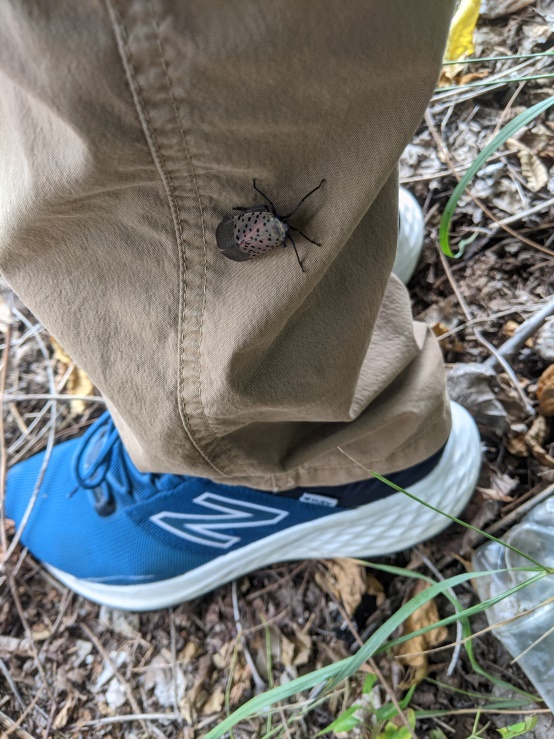March 29, 2022
Residents Urged To Watch For, Destroy Spotted Lanternflies

Adult spotted lanternfly
CHAMBERSBURG, Pa. – The Franklin County Commissioners and the Franklin County Planning Department remind residents to be vigilant in monitoring for spotted lanternflies.
Spotted lanternflies do not bite or sting and pose no threat to human health. However, the insect is a plant stressor and can cause significant damage to trees, plants and shrubs. Spotted lanternflies also secrete a sticky, pungent residue that is not only foul-smelling but can be messy for homeowners.
The spotted lanternfly is an invasive species first detected in southeastern Pennsylvania in 2014. Since then, the spotted lanternfly has spread in every geographical direction and was first spotted in Franklin County in 2020. In 2021, Franklin County was added to the state’s list of quarantine zones, meaning the county now has a sustainable, reproducing population of spotted lanternflies. Some areas of the county experienced heavy infestation in 2021 and it is likely the county will experience an even higher infestation in 2022.
Knowing what to look for and when is key to combating the spotted lanternfly. Residents may notice the spotted lanternfly in a larval state between April and July. In this stage, the larvae will be black with white dots. By July, the larvae will have an orange/red color along with the black and white dots.
The insect will reach adulthood starting in late July. At this time, spotted lanternflies will have wings with black dots and will measure about 1 inch long. Between September and November, the insect will begin laying egg masses that resemble a gray-brown mud material on trees. These eggs will survive over the winter before the process begins again the following spring.
Generally speaking, spotted lanternflies are found predominantly on trees, shrubs and other vegetation. However, they can be found on anything, including vehicles and buildings.
The following are options for controlling spotted lanternflies, listed in order of the most environmentally friendly and cost-efficient options to the least. It is recommended starting with the first option and progressing through the list only if the other options do not achieve results.
- Inspection of vehicles before leaving and returning home: Checking your vehicle for any spotted lanternfly life stages can go a long way in preventing spotted lanternflies from traveling to or from your property. Be sure to inspect the surfaces and wheel wells of all vehicles, and encourage your friends, family and neighbors to do the same.
- Cultural control: Spotted lanternflies feed on more than 70 species of plants, but the tree of heaven is the insect’s preferred host. Like the spotted lanternfly, the tree of heaven is also an invasive species from Asia. By removing this tree from your property, you reduce the likelihood of a spotted lanternfly infestation.
- Physical/mechanical control: Remove the spotted lanternfly threat by scraping, smashing, swatting, stomping or using traps to eliminate eggs, nymphs and moths.
- Reduced-toxicity chemical control: Begin by using the least-toxic chemical options first, such as insecticidal soaps, botanical oils and pyrethrum.
- Chemical control: Use EPA-registered chemicals as contact or systemic applications, including dinotefuran, bifenthrin, zeta-cypermethrin and carbaryl. These may have a longer lasting effect.
For your safety, the safety of the environment and by law, those who choose reduced-toxicity chemical control or chemical control must follow the chemicals’ instruction labels. A chemical control may also warrant a certified applicator.
For more information, contact Franklin County’s Penn State Extension Office at 717-263-9226 or visit extension.psu.edu for a Spotted Lanternfly Management Guide.
Return to list.

